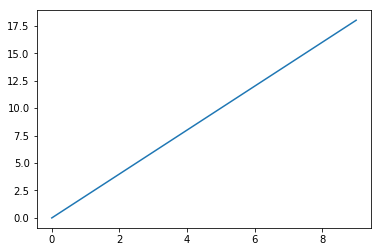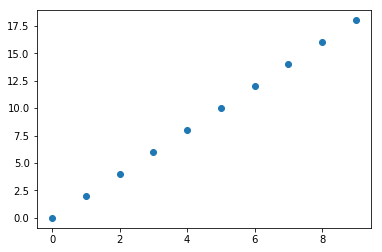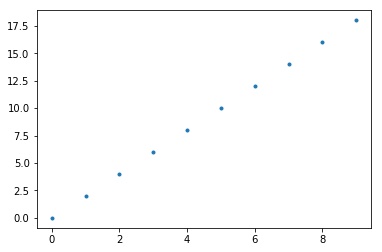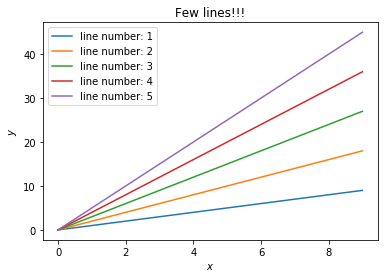Week 1
Online/in-Person Graduate course, University of California, Riverside, Department of Physics and Astronomy, 2019
The Foundation of Applied Machine Learning
Spring 2019
Instructor: Prof. Bahram Mobasher
Teaching Assistance: Abtin Shahidi email abtin.shahidi–at–email.ucr.edu
Go to Week 2 »
A general introduction to python 3
Python is an interpreted, generel-purpose, and high-level programming language.
- The python code is automatically compiled to a byte code and then executed; which make it perfect for using it as scripting language. On the other hand languages such as C need to be compiled on the machine first then can be executed. (which make the program in C to be very fast)
- The python has built-in high level data structures: list, string, dictionary, tuple, …
- Very large community which makes the debugging much easier as well as having access to a comprehensive standard library.
- Python supports multiple programming paradigms, including object-oriented, imperative, functional and procedural.
Installing Python on your machine:
Creating Virtual environment: (optional but highly recommended)
- It is a better practice to install python in a virtual environment to avoid any future dependency errors. For installing virtual enviroment you can use any of the following methods:
- pipenv
- venv
- installing conda (Package, dependency and environment management for any language) and using it’s environment manager.
- The most straight forward and easy to use way is to use virtualenvwrapper; it put all your packages in the same place, which makes it much easier to find and manage them after making tons of projects or virtual environment.
Let’s install virtualenvwrapper: (python 3)
1. Install pip:
For installing on Ubuntu and Debian:
First update to make sure the package will be there:
sudo apt-get update
sudo apt-get upgrade
Now install the pip3:
sudo apt-get install python3-pip
For installing on CentOS:
sudo yum install python34-setuptools
sudo easy_install pip
For installing on Fedora:
sudo dnf install python3-pip.
2. Install virtualenv
sudo pip3 install virtualenv
3. Install virtualenvwrapper
sudo pip3 install virtualenvwrapper
4. Setup the shell startup file
- Add the following lines to your shell startup file (.bashrc, .profile, etc.) to set the location which the virtual environments should be and the location of the script installed with this package:
export WORKON_HOME=$HOME/.virtualenvs source /usr/local/bin/virtualenvwrapper.sh - After editing it, reload the startup file (e.g., run source ~/.bashrc). Now test and build your own virtual-environment via command line:
mkvirtualenv temp
workon temp
pip3 install <packages>
deactivate
This is the full syntax for mkvirtualenv. (requirement file is very useful when you have a list of needed packages and you want to install all of them with one command)
mkvirtualenv [-a project_path] [-i package] [-r requirements_file] [virtualenv options] ENVNAME
This is the way to install all the packages needed.
For checking the command references for virtualenvwrapper check https://virtualenvwrapper.readthedocs.io/en/latest/command_ref.html
—-> Now go ahead and build a Machine-learning virtual enviroment:
mkvirtual ML
workon ML
pip3 install numpy matplotlib
One of the easiest ways to develop python codes (interactive feature) is to use jupyter notebook and jupyter lab. They can be installed with pip3 install. But first make sure you have an updated version of pip installed:
pip3 install --upgrade pip
Then:
pip3 install jupyter
Now you can access jupyter notebook under your current directory if you type in the following:
jupyter notebook
If you want to install jupyter lab, run the following:
pip3 install jupyterlab
For further details click on the links below:
- Now you can check your installed packages by:
pip3 freeze
- And you can save them in a text file for future use:
pip3 freeze > requirement.txt
Python as a simple calculator!!
- It is very easy to define variables and do various calculation with them:
3+2
5
7-4
3
# The syntax for devision is different in python 2
5/9
0.5555555555555556
4*20
80
x=10
y=20
print(x-y,x+y, x/y,x*y)
-10 30 0.5 200
- In interactive mode, the last printed expression is assigned to the variable _
x+y
30
20 + _
52
5 + _
57
Control Flow Tools
1.while statement
x=20
y=1
while y<x:
y+=1
print(y,x)
20 20
———————————————————————
2. If statement
x=20
y=1
if x!=2:
y+=1
elif x!=3:
y+=2
else:
y+=10
print(y,x)
2 20
———————————————————————
3. For loop
for i in range(4):
print(i)
0
1
2
3
list_1= [12,13,11,5]
for i in list_1:
print(i)
12
13
11
5
More info: : https://docs.python.org/3/tutorial/controlflow.html
Built-in data structures
1. Strings
It is relatively easy to work with strings in python
Defenition:
str_1="Today"
str_2="is"
str_3="Friday"
str_1+str_2
'Todayis'
str_1+" "+str_2
'Today is'
str_f=str_1+" "+str_2 + " " +str_3
str_f
'Today is Friday'
Using the indexing for getting each character: (remmeber that the index in python starts with 0)
str_1[0]+str_1[2]
'Td'
Useful way when dealing with big strings
("Hello" " " "World" "!!!")
'Hello World!!!'
———————————————————————
2. Lists
List are very useful objects for keeping a list of some data
Defenition:
my_list_1 = [1,2,5,7,11,15,21]
my_list_2 = [1,12,"Hello"]
# Defenition of adding lists:
my_list_1+my_list_2
[1, 2, 5, 7, 11, 15, 21, 1, 12, 'Hello']
- Finding the value with index and common use of indexing syntax:
my_list_1[0]
1
my_list_1[-1]
21
my_list_1[3:6]
[7, 11, 15]
my_list_1[:6]
[1, 2, 5, 7, 11, 15]
my_list_1[3:]
[7, 11, 15, 21]
- Multiplying a list by a number: The number only can be integer. (else result in a TypeError)
3.2*my_list_1
---------------------------------------------------------------------------
TypeError Traceback (most recent call last)
<ipython-input-41-0a94c0c5a776> in <module>
----> 1 3.2*my_list_1
TypeError: can't multiply sequence by non-int of type 'float'
3.*my_list_1
---------------------------------------------------------------------------
TypeError Traceback (most recent call last)
<ipython-input-42-7c4df6de0708> in <module>
----> 1 3.*my_list_1
TypeError: can't multiply sequence by non-int of type 'float'
3*my_list_1
[1, 2, 5, 7, 11, 15, 21, 1, 2, 5, 7, 11, 15, 21, 1, 2, 5, 7, 11, 15, 21]
Exactly the same result if we did the following:
my_list_1+my_list_1+my_list_1
[1, 2, 5, 7, 11, 15, 21, 1, 2, 5, 7, 11, 15, 21, 1, 2, 5, 7, 11, 15, 21]
Common ways to create a list
# 1
my_list_1=[12,31,4]
# 2
my_list_2=[]
for i in my_list_1:
my_list_2.append(i)
# 3
my_list_3=[i for i in my_list_1]
print(my_list_1,my_list_2, my_list_3)
[12, 31, 4] [12, 31, 4] [12, 31, 4]
———————————————————————
3. Dictionary
Dictionaries in python are very useful and very fast since they use hashing algorithms.
Defenition:
my_dictionary={} # my_dictionary={key:value}
keys=["hello", 12, 15, 11., "No", (12,9), "l"]
values=[12, 4, 1, "why", 14., " ", [12,41,5]]
my_dictionary={keys[0]:values[0]}
my_dictionary
{'hello': 12}
my_dictionary={keys[0]:values[0], keys[1]:values[1]}
my_dictionary
{'hello': 12, 12: 4}
my_dictionary={key:value for key,value in zip(keys,values)}
my_dictionary
{'hello': 12,
12: 4,
15: 1,
11.0: 'why',
'No': 14.0,
(12, 9): ' ',
'l': [12, 41, 5]}
Important: The Key can be any immutable object such as strings, numbers, and tuples. However, the Value can be any object. (mutable and immutable)
- Few useful syntax for getting back the values, keys, (key,value) pairs:
my_dictionary["hello"]
12
- If the key is not in the dictionary you going to get KeyError
my_dictionary["hell"]
---------------------------------------------------------------------------
KeyError Traceback (most recent call last)
<ipython-input-63-f26ba78a1716> in <module>
----> 1 my_dictionary["hell"]
KeyError: 'hell'
my_dictionary.keys()
dict_keys(['hello', 12, 15, 11.0, 'No', (12, 9), 'l'])
my_dictionary.values()
dict_values([12, 4, 1, 'why', 14.0, ' ', [12, 41, 5]])
my_dictionary.items()
dict_items([('hello', 12), (12, 4), (15, 1), (11.0, 'why'), ('No', 14.0), ((12, 9), ' '), ('l', [12, 41, 5])])
Special use in the for loops on the keys, Both of the following ways are equivalent:
for key in my_dictionary.keys():
print(my_dictionary[key])
12
4
1
why
14.0
[12, 41, 5]
for key in my_dictionary:
print(my_dictionary[key])
12
4
1
why
14.0
[12, 41, 5]
We can make nested dictionaries very easy:
dict_1={"x":2, "y":[12,4]}
dict_2={"first_dict":dict_1}
dict_2
{'first_dict': {'x': 2, 'y': [12, 4]}}
dict_2["first_dict"]['x']
2
Importing packages and modules
Different ways of calling a particular module/method (linspace)
# 1
import numpy
numpy.linspace(1,10,20)
array([ 1. , 1.47368421, 1.94736842, 2.42105263, 2.89473684,
3.36842105, 3.84210526, 4.31578947, 4.78947368, 5.26315789,
5.73684211, 6.21052632, 6.68421053, 7.15789474, 7.63157895,
8.10526316, 8.57894737, 9.05263158, 9.52631579, 10. ])
# 2
import numpy as np # np is just a convention
np.linspace(1,10,20)
array([ 1. , 1.47368421, 1.94736842, 2.42105263, 2.89473684,
3.36842105, 3.84210526, 4.31578947, 4.78947368, 5.26315789,
5.73684211, 6.21052632, 6.68421053, 7.15789474, 7.63157895,
8.10526316, 8.57894737, 9.05263158, 9.52631579, 10. ])
from numpy import linspace
linspace(1,10,20)
array([ 1. , 1.47368421, 1.94736842, 2.42105263, 2.89473684,
3.36842105, 3.84210526, 4.31578947, 4.78947368, 5.26315789,
5.73684211, 6.21052632, 6.68421053, 7.15789474, 7.63157895,
8.10526316, 8.57894737, 9.05263158, 9.52631579, 10. ])
Some Useful packages and modules:
1. Numpy look at the full Documentation
NumPy provides efficient storage and better ways of handling data for Mathematical Operations
import numpy as np
Numpy arrays are relatively fast and have many useful features
Defenition:
my_list=[1,4,5]
x=np.array(my_list)
print(x)
[1 4 5]
Notice that the elements are kept as integer. (as they were in the list)
———————————————-
my_list=[1.0,4,5]
x=np.array(my_list)
print(x)
[1. 4. 5.]
Notice that the elements are turn into float. (even with only the first element was float in the list)
———————————————-
my_list=[1.0,4,5,"goods"]
np.array(my_list, dtype=np.int32)
---------------------------------------------------------------------------
ValueError Traceback (most recent call last)
<ipython-input-114-909efabe753f> in <module>
1 my_list=[1.0,4,5,"goods"]
----> 2 np.array(my_list, dtype=np.int32)
ValueError: invalid literal for int() with base 10: 'goods'
my_array_0=np.array([12,5,6], dtype=complex)
my_array_0
array([12.+0.j, 5.+0.j, 6.+0.j])
- For keeping the type you should use a list in which all the elements have the same type
my_array_1=np.array([1,3,14.,15])
my_array_2=np.array([11,2,40.])
my_array_3=np.array([12,43,42.])
my_array_2+my_array_2
array([22., 4., 80.])
my_array_2-my_array_3
array([ -1., -41., -2.])
my_array_1+my_array_2
---------------------------------------------------------------------------
ValueError Traceback (most recent call last)
<ipython-input-118-64ed6476a96a> in <module>
----> 1 my_array_1+my_array_2
ValueError: operands could not be broadcast together with shapes (4,) (3,)
my_array_2*my_array_3
array([ 132., 86., 1680.])
my_array_2/my_array_3
array([0.91666667, 0.04651163, 0.95238095])
3*my_array_1
array([ 3., 9., 42., 45.])
my_array_3/6
array([2. , 7.16666667, 7. ])
Indexing is like the lists
my_array_1[0]
1.0
my_array_1[-1]
15.0
Choosing a subset:
my_array_1[my_array_1>4]
array([14., 15.])
my_array_1[my_array_1<4]
array([1., 3.])
Making a simple matrix
qqq=np.array([[1,2],[4,5]])
mqqq=np.asmatrix(qqq)
mqqq
matrix([[1, 2],
[4, 5]])
qqq[0,0]
1
qqq[0][0]
1
Notice that there is no difference
———————————————–
mqqq[0,0]
1
mqqq[0][0]
matrix([[1, 2]])
Notice that there is a difference for two different way of getting value with the index
———————————————–
2. Matplotlib look at the full Documentation
Matplotlib is a Python 2D plotting library which produces publication quality figures in a variety of hardcopy formats and interactive environments across platforms.
The matplotlib library is huge and it takes time to be familiar with it’s features!
import matplotlib.pyplot as plt # plt is just a convention
x=[i for i in range(10)]
y=[2*i for i in range(10)]
plt.plot(x,y)
plt.show()

plt.scatter(x,y)
plt.show()

plt.plot(x,y, '.')
plt.show()

It can be used in the for loop for several lines:
x=[i for i in range(10)]
for j in range(5):
J=j+1
y=[J*i for i in range(10)]
plt.plot(x,y, label="line number: {}".format(J))
plt.legend()
plt.show()

Adding title and label for axis
x=[i for i in range(10)]
for j in range(5):
J=j+1
y=[J*i for i in range(10)]
plt.plot(x,y, label="line number: {}".format(J))
plt.title(r"Few lines!!!")
plt.xlabel(r"$x$")
plt.ylabel(r"$y$")
plt.legend()
plt.show()

